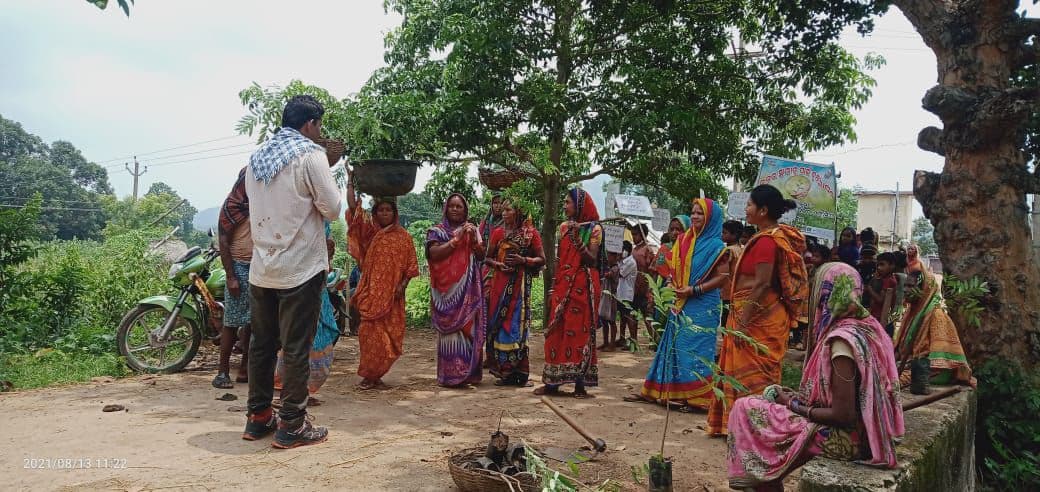Community action for strengthening springs
StoryBy Chandrika Patnaik
25 October 2021
The Nuasahi village community undertakes natural resource management initiatives to revive the springs, protect their water sources, and ensure continuous water supply.

Women and men of Nuasahi village hold a rally to mobilize people for plantation and to spread awareness on groundwater recharge.
Photograph by Roshi Soni
Nuasahi is a small habitation in Odisha in Tarasingi Gram Panchayat of Ganjam District. All 35 households in the village have a tap connection supplied from a spring. The village receives water throughout the year, sufficient for household consumption and other domestic uses. However, the spring dries during summer, and the village faces a water shortage. “Two or three years ago, we had sufficient water availability. We used it for drinking, for domestic purposes and for farming as well. We never had to depend on other sources of water. Now we struggle to fulfil the water for drinking purposes also,” says Murali Jani, a resident of Nuasahi.
Gram Vikas conducted a close analysis of the springshed area. We found that the intake well did not receive sufficient water due to increased rainwater runoff in the spring’s catchment area. The most runoff was in the empty patches of land near the intake well area. The village collectively decided to plant trees around the catchment area of the spring.
During community meetings, the residents discussed the plantations in the reserve forest area by the Forest Department. They suggested plantations around the intake well and catchment area and getting support from the Forest Department. Gram Vikas staff then took this issue to the Forest Department, who agreed to provide 1,200 saplings.
The community planted saplings of plants such as Simarouba (planted for its water holding capacity), Tamarind (as it is not cut off for usage by the Adivasi communities) and Amla (for its soil holding capacity). All the work was done voluntarily by the villagers. They see it as an investment today to secure future generations’ water needs when climate change has affected natural resources.
The Village Committee and SHG members have taken the responsibility of caring for the plants. Through this activity, they understood the need to secure their water needs. They have decided to work further towards this by working on small drainages and runoff areas of the springshed. They will reach out to the forest department and MGNREGS for this work.
Mandakini Jani from Maa Changudi SHG talks about the urgency to act now, “20-30 years ago, when we were growing up, the water did not have any price. It was free and available to everybody in sufficient quantity. Nowadays, there is a price to pay for water. We must spend even to drink water when we go out in the town or cities. The condition from 30-40 years from now will be more drastic. We need to take steps now.”
Mandakini planting a Simarouba sapling as part of the plantation work.
Photograph by Dulabha Odandra
ACKNOWLEDGEMENT
Reporting by Roshi Soni, Dulabha Odandra. Ganesh Chakravarthi edited the document.
ABOUT THE AUTHOR
Chandrika Patnaik leads on content production in the Communications team.
RELATED BLOGPOSTS
Turning losses into gains: How Mallipanka farmers find success in new crops
Reviving agriculture: Mallipanka’s first strawberry farm story.
Ensuring dignity beyond life: supporting migrant families in their darkest hours
Gram Vikas ensures safe migration and dignified repatriation for deceased migrant workers, supporting bereaved families.
Collective leadership transforms ageing overhead water tank to secure household water supply for all
Kalakhadi’s aging overhead tank revived through collective leadership, ensuring sustainable water supply for the community.